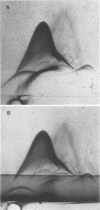Abstract
In sera from 12 patients with polar tuberculoid leprosy, 12 with subpolar tuberculoid leprosy, and 16 with lepromatous leprosy were demonstrated a total number of 125 anti-BCG precipitins by means of crossed immunoelectrophoresis with intermediate gel. Up to 14 different precipitins were found in individual sera, and the complexity in antibody response was higher than previously realized. The specificity of 69% of the antibodies was defined, and these antibodies were titrated in three arbitrary titer units. A highly significant difference (P < 0.002) was found in antibody response between the tuberculoid and the lepromatous group. Due to simplicity, sensitivity, and high resolution, the method used is a promising tool for providing exact data to be used as guidelines for purification of important individual mycobacterial antigens. The need for reference antisera is emphasized.
Full text
PDF






Images in this article
Selected References
These references are in PubMed. This may not be the complete list of references from this article.
- Axelsen N. H. Intermediate gel in crossed and in fused rocket immunoelectrophoresis. Scand J Immunol Suppl. 1973;1:71–77. doi: 10.1111/j.1365-3083.1973.tb03782.x. [DOI] [PubMed] [Google Scholar]
- Axelsen N. H., Kirkpatrick C. H. Simultaneous characterization of free Candida antigens and Candida precipitins in a patient's serum by means of crossed immunoelectrophoresis with intermidiate gel. J Immunol Methods. 1973 Apr;2(3):245–249. doi: 10.1016/0022-1759(73)90050-1. [DOI] [PubMed] [Google Scholar]
- Axelsen N. H. Quantitative immunoelectrophoretic methods as tools for a polyvalent approach to standardization in the immunochemistry of Candida albicans. Infect Immun. 1973 Jun;7(6):949–960. doi: 10.1128/iai.7.6.949-960.1973. [DOI] [PMC free article] [PubMed] [Google Scholar]
- Godal T., Myklestad B., Samuel D. R., Myrvang B. Characterization of the cellular immune defect in lepromatous leprosy: a specific lack of circulating Mycobacterium leprae-reactive lymphocytes. Clin Exp Immunol. 1971 Dec;9(6):821–831. [PMC free article] [PubMed] [Google Scholar]
- Godal T., Myrvang B., Froland S. S., Shao J., Melaku G. Evidence that the mechanism of immunological tolerance ("central failure") is operative in the lack of host resistance in lepromatous leprosy. Scand J Immunol. 1972;1(4):311–321. doi: 10.1111/j.1365-3083.1972.tb03296.x. [DOI] [PubMed] [Google Scholar]
- LOWRY O. H., ROSEBROUGH N. J., FARR A. L., RANDALL R. J. Protein measurement with the Folin phenol reagent. J Biol Chem. 1951 Nov;193(1):265–275. [PubMed] [Google Scholar]
- Moran C. J., Ryder G., Turk J. L., Waters M. F. Evidence for circulating immune complexes in lepromatous leprosy. Lancet. 1972 Sep 16;2(7777):572–573. doi: 10.1016/s0140-6736(72)91962-9. [DOI] [PubMed] [Google Scholar]
- Myrvang B., Godal T., Ridley D. S., Fröland S. S., Song Y. K. Immune responsiveness to Mycobacterium leprae and other mycobacterial antigens throughout the clinical and histopathological spectrum of leprosy. Clin Exp Immunol. 1973 Aug;14(4):541–553. [PMC free article] [PubMed] [Google Scholar]
- Navalkar R. G. Immunologic analysis of Mycobacterium leprae antigens by means of diffusion-in-gel methods. Int J Lepr Other Mycobact Dis. 1971 Apr-Jun;39(2):105–112. [PubMed] [Google Scholar]
- Norlin M., Navalkar R. G., Ouchterlony O., Lind A. Characterization of leprosy sera with various mycobacterial antigens using double diffusion-in-gel analysis. 3. Acta Pathol Microbiol Scand. 1966;67(4):555–562. doi: 10.1111/apm.1966.67.4.555. [DOI] [PubMed] [Google Scholar]
- Rees R. J., Chatterjee K. R., Pepys J., Tee R. D. Some immunologic aspects of leprosy. Am Rev Respir Dis. 1965 Dec;92(6):139–149. doi: 10.1164/arrd.1965.92.6P2.139. [DOI] [PubMed] [Google Scholar]
- Ridley D. S., Jopling W. H. Classification of leprosy according to immunity. A five-group system. Int J Lepr Other Mycobact Dis. 1966 Jul-Sep;34(3):255–273. [PubMed] [Google Scholar]
- Ridley D. S., Waters M. F. Significance of variations within the lepromatous group. Lepr Rev. 1969 Jul;40(3):143–152. doi: 10.5935/0305-7518.19690026. [DOI] [PubMed] [Google Scholar]
- Weeke B. Crossed immunoelectrophoresis. Scand J Immunol Suppl. 1973;1:47–56. doi: 10.1111/j.1365-3083.1973.tb03778.x. [DOI] [PubMed] [Google Scholar]
- Wemambu S. N., Turk J. L., Waters M. F., Rees R. J. Erythema nodosum leprosum: a clinical manifestation of the arthus phenomenon. Lancet. 1969 Nov 1;2(7627):933–935. doi: 10.1016/s0140-6736(69)90592-3. [DOI] [PubMed] [Google Scholar]



